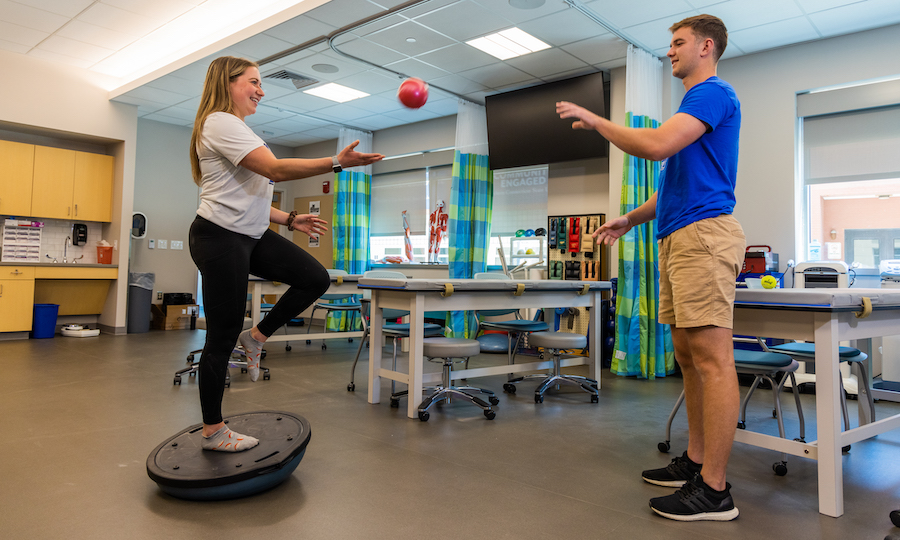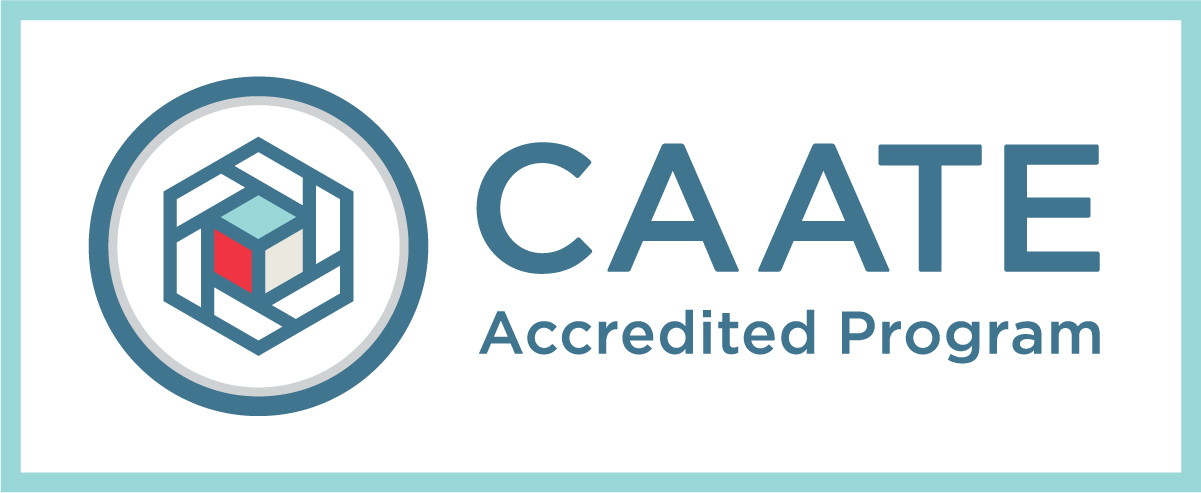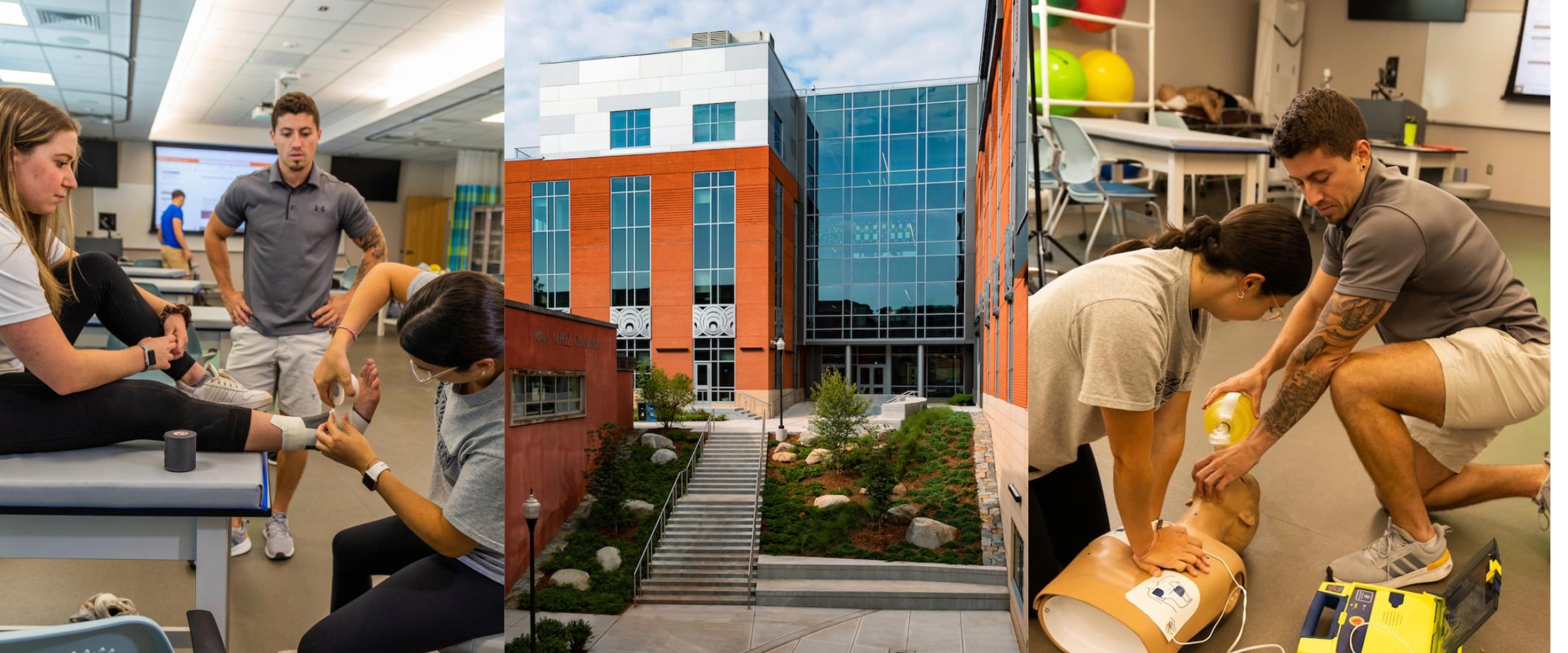The 3+2 accelerated pathway is a 150-credit five-year program consisting of 98 undergraduate credits, including 22 accelerated dual credit courses that count towards the bachelor’s and master’s degrees, and 40 stand-alone graduate credits.
Athletic training is an AMA-recognized profession dedicated to preventing, examining, treating, and rehabilitating injuries and illnesses. Athletic trainers provide health care across the lifespan for amateur and professional athletics teams, occupational settings, tactical groups (ie police, military), performing arts, and medical facilities. The profession is in a period of rapid growth in terms of the number of positions available with an expected increase of 17% over the next ten years according to the US Bureau of Statistics and a 14.6% increase in Connecticut alone.
Built on Connecticut’s longest accredited undergraduate athletic training program, the BS/MAT Accelerated Athletic Training program is organized in a 3 + 2 structure. During the first three years at Southern Connecticut, students complete 98 credits of undergraduate study focusing on prerequisite coursework related to the biological, physical, social, and exercise sciences. During the last two years, students complete the remaining 62 credits of graduate athletic training courses and clinical requirements before graduating with the MAT degree, where they will be eligible to sit for the national entry-level Board of Certification examination to become an athletic trainer.
Students start their graduate athletic training studies during the first summer after admission into the graduate athletic program. The subsequent study follows the traditional fall and spring semester schedule, with each semester divided into 8-week block scheduling. One 8-week block is devoted to a period of concentrated classroom study with the second 8-week block dedicated to an immersive clinical experience under the supervision of program-approved preceptors.
Program Requirements ›› Admissions and Retention Requirements ››

- Students begin their graduate studies during the first summer after admission into the Master of Athletic Training. The subsequent curriculum follows the traditional fall and spring semesters schedule, with each semester divided into 8-week block scheduling. We dedicate one 8-week block to classroom and laboratory learning and the other 8-week block to full-time, hands-on clinical experience under the supervision of program-approved preceptors.
- Our program includes face-to-face classroom instruction in a broad array of healthcare services including preventative and primary care, diagnostic techniques, acute and emergent care procedures, care planning, therapeutics, clinical measures, healthcare delivery, administration, and management strategies.
- We integrate clinical education throughout the program. Clinical education includes four full-time immersive clinical experiences, simulations, and other patient-based education opportunities. Full-time immersive clinical experiences provide learning opportunities for students with real patients to demonstrate knowledge, skills, and behaviors in actual patient-care settings and prepare students for independent clinical practice. Simulations and other patient-based education opportunities allow students to provide care in a controlled and safe environment to prepare students for independent clinical practice.
- Each student will have a chance to work with patients during clinical experiences or simulations from various populations, including patients throughout their lifespan, of different sexes, from different socioeconomic statuses, of varying levels of activity and athletic ability, and who participate in non-sport activities.
- During clinical experiences and simulations, students will gain experience with patients with various health conditions commonly seen in athletic training clinical practice.
- Housed in the Department of Health and Movement Sciences within the College of Health and Human Services, we offer students opportunities to interact and learn with and from students in other health professions such as clinical exercise physiology, marriage and family therapy, nursing, public health, respiratory therapy, social work, speech-language pathology, sport psychology, and therapeutic recreation.
- Students participate in patient-based education opportunities, such as clinical decision-making and case studies, where students develop, extend and refine their knowledge and skills in assessing complex cases, making informed decisions, and implementing effective care plans.
- Students self-select and participate in professional development activities embedded in courses through mechanisms such as volunteerism; joining and engaging in professional organizations; attending local, regional, and national meetings, conferences, and workshops sponsored by professional organizations; serving as an officer, board member, or committee member in a campus club, and assisting with and conducting research.
- Students are required to pass a comprehensive examination. The comprehensive examination is the culminating academic event for students enrolled in the Master of Athletic Training and administered in the student’s final semester in the program. The comprehensive examination requires students to demonstrate their ability to organize and synthesize knowledge and apply skills developed throughout the program.
- Reduced tuition for New England residents (Maine, Massachusetts, New Hampshire, New Jersey, New York, Rhode Island, Vermont, and Pennsylvania) is available through the New England Board of Higher Education (NEBHE) Tuition Break program.
- State of the art fully functional athletic training classroom/laboratory for teaching and clinical education
- The first program to meet the State of Connecticut Department of Public Health requirements for employment in the occupational setting
The undergraduate portion of the 3+2 athletic training accelerated pathway curriculum provides students with a solid background in the Biological, Physical, Social, and Exercises Sciences to prepare them for advanced and in-depth coursework within the Master of Athletic Training.
- Biology
- Anatomy and Physiology
- Chemistry
- Physics
- Psychology
- Statistics
- Strength and Conditioning
- Exercise Physiology
- Sports Psychology
- Biomechanics
- Nutrition
Once admitted into the Master of Athletic Training, the curriculum addresses various topics through an effective blend of theoretical knowledge and practical application; students will develop the knowledge and behaviors needed to excel as skilled athletic trainers in athletic training and sports medicine.
- Clinical Anatomy: In-depth study of human anatomy and the physiological processes related to athletic performance, injuries, and other health conditions.
- Biomechanics: Advanced understanding of the mechanical principles governing human movement, analysis of sports-specific movements, and their application to injury prevention and rehabilitation.
- Exercise Physiology: Exploring how the body responds and adapts to exercise and how physiological systems influence athletic performance.
- Nutrition: Advanced understanding of proper nutrition and its role and impact on prevention, athletic performance, and recovery.
- Technology and Sports Medicine: Exploring the use of biometrics and physiological monitoring systems in preventive measures, clinical interventions, and performance enhancement.
- Pathophysiology In-depth study of the mechanisms behind health conditions focusing on the interactions between cells, tissues, organs, and systems within the body helping athletic trainers make informed decisions about patient care.
- Pathomechanics: Advanced study of abnormal movements and how changes in the body's musculoskeletal system's structure, function, or alignment can alter normal movement mechanics and contribute to various conditions leading to dysfunction, injury, or pain that guide assessment, diagnosis, and treatment.
- Patient-Centered Care: Exploring advocating for the health needs of patients, communities, and populations and analyzing the impact of health literacy and social determinants of health on patient care and outcomes.
- Prevention: In-depth study of strategies for identifying risks, implementing plans to aid in risk reduction, promoting health literacy, optimizing wellness, and facilitating safety by monitoring, evaluating, and responding to environmental conditions
- Assessment, Evaluation, and Diagnosis: In-depth study of injuries specific to various sports and activities; understanding of health conditions affecting athletes and physically active individuals; performing or obtaining diagnostic or laboratory tests; and advanced procedures for evaluating patients to differential diagnosis injuries and other health conditions.
- Critical Incident Management: Training to provide immediate care for acute injuries and other emergent health conditions and manage medical emergencies.
- Care Planning: Hands-on experience with various techniques, equipment, patient-reported and clinician-rated outcome measures, and protocols for injuries and other health conditions
- Orthopedic Therapeutic Intervention: In-depth study of physical agents to facilitate healing and recovery, such as ice, heat, therapeutic ultrasound, electrical stimulation, traction, intermittent compression, LASER, and diathermy; manual therapy, including joint and soft tissue mobilizations, manipulation, proprioceptive neuromuscular facilitation, myofascial release and decompression, and muscle energy; and therapeutic exercises to restore neuromuscular control, mobility, flexibility, strength, endurance, motor control, core stability, and functionality after injuries.
- Therapeutic Devices: Learn to select and fit assistive and restrictive off-the-shelf durable medical equipment, orthoses, and splints and fabricate customized wrapping, taping, protective padding, and casting techniques and procedures.
- Pharmacology: Detailed knowledge of common therapeutic medications, their indications, contraindications, dosing, effects, interactions, adverse reactions, and administration by the appropriate route.
- Athlete Wellness and Mental Health: Exploring the psychological aspects of injuries, coping with injuries, factors affecting performance and the recovery process, educating others about the effects, participation consequences, and risks of misuse and abuse of drugs and performance-enhancing substances; and strategies for identifying behavioral health conditions and addressing the mental well-being of athletes and physically active individuals.
- Professional Standards and Ethics: Learning to practice health care that complies with professional standards, ethical responsibilities, legal considerations and issues, and scope of practice in athletic training.
- Research Methods and Evidence-Based Practice: Training in critical analysis of epidemiology and research in athletic training and sports medicine and providing athletic training services using evidence to inform clinical practice.
- Communication Skills: Develop effective skills for communicating effectively and appropriately with patients, family members, coaches, administrators, policymakers, payors, physicians, and other healthcare professionals.
- Leadership and Management: Developing skills to lead athletic training programs, manage healthcare teams, and collaborate with physicians, other healthcare professionals, coaches, and performance enhancement specialists.
- Interprofessional Education and Practice: Learn to collaborate with physicians, other healthcare professionals, coaches, and performance enhancement specialists.
- Special Populations and Adapted Athletic Training: Addressing the unique needs of diverse populations, including pediatric, geriatric, and adaptive athletes.
- Healthcare Administration: Performing administrative duties for managing physical, human, and financial resources.
- Quality Improvement and Informatics: Using quality assurance and quality improvement systems to enhance patient care and apply contemporary principles and practices of health informatics to the administration and delivery of patient care.
- Professional Development: Preparing for certification and licensure, self-assessing professional competence and creating professional development plans, advocating for the profession, and staying up-to-date with emerging trends and the latest advancements in athletic training and sports medicine.
Goal #1: As a healthcare team member, students will practice athletic training autonomously, in conjunction with a collaborating or supervising physician.
- Develop and implement strategies to manage risks and develop health promotion and wellness programs for individuals and groups impacted by or involved in specific activities through awareness, education, and intervention.
- Examine patients with acute and emergent health conditions to formulate a diagnosis, coordinate a care plan, implement an appropriate action, and identify participation restrictions.
- Employ immediate and emergency care by stabilizing and/or preventing the exacerbation of a condition to reduce morbidity and mortality risk.
- Create and implement care plans based on the findings of an examination by selecting and applying therapeutic interventions that align with the care plan.
- Manage a healthcare facility and activity area to guide the daily operation of athletic training services.
Goal #2: Students will develop, extend, and refine athletic training knowledge, skills, and clinical decision-making abilities.
- Apply and analyze strategies to mitigate the risk for health conditions across the lifespan for individuals and groups impacted by or involved in activities through awareness, education, and intervention.
- Apply and analyze examination and diagnosis techniques for acute and emergent health conditions to formulate a diagnosis, coordinate a care plan, implement an appropriate course of action, and identify participation restrictions.
- Apply and analyze immediate and emergency care procedures to stabilize and/or prevent the exacerbation of a condition to reduce the risk of morbidity and mortality.
- Develop and analyze care plans and the selection and application of therapeutic interventions that align with the plan of care.
- Apply and analyze healthcare organization and administration principles to guide the daily operation of athletic training services.
Goal #3: Students will model and promote professional behaviors fundamental to healthcare professionals within and across diverse contexts.
- Provides compassionate and respectful care sensitive to diverse patient populations and includes the patient (and family/associates where appropriate) in the health care decision-making process.
- Learns and practices in collaboration with other healthcare and wellness professionals.
- Incorporates patient circumstances (needs, concerns, preferences), best available evidence, clinical expertise, and outcomes to inform clinical practice and guide clinical decision-making.
- Practices self-directed learning by continuously developing, extending, and refining AT knowledge, skill, and behaviors to enhance patient care based on continuous self-assessment and feedback.
- Collects, stores, retrieves, analyzes, and uses health data to enhance patient outcomes.
- Carries out professional responsibilities by exhibiting integrity, accountability, respectful interactions, and ethical and legal behavior in professional conduct.
Goal #4: The program will provide a learning environment that offers students an exemplary graduate education committed to academic excellence, access, social justice, and service for the public good.
- Prepare students for the BOC entry-level athletic training certification examination.
- Provide approachable, knowledgeable, and dedicated educators in didactic and clinical settings who provide a quality learning environment.
- Individualize educational experiences for each student based on a student’s personal and professional interests and accreditation standards.
- Remove systemic barriers to equity, access, and success for all students and create an inclusive culture by committing to constructive dialogues where all are treated with dignity, respect, kindness, compassion, and civility.
- Contribute to the community and athletic training profession by promoting health and access to healthcare for individuals, communities, and the larger public.
In addition to the direct costs that appear on a student’s University bill (e.g., tuition and university fees), once admitted to the Master of Athletic Training, students are responsible for paying a clinical course fee of $75 per semester (this is considered a direct cost and WILL appear on a student's bill for the graduate program) and any indirect costs associated with attending the University as a graduate student, including the Master of Athletic Training and do NOT appear on a student’s bill. These indirect costs include:
- Personal expenses (estimate of costs for clothing, toiletries, etc.): $1,000
- Emergency cardiac care certification: $24
- Housing and meals: $9,000
- Transportation (traveling to and from campus/clinical sites and operating and maintaining a vehicle): $2,500
- Course materials (books, supplies, equipment, clinical education computer tracking software, online examinations, etc.): $1,200
- Medical (immunizations and provider evaluation and care): varies based on insurance
- Background checks (per clinical site requirements) vary based on clinical site: $0-200
Please note these are estimated costs from the Office of Financial Aid, based upon full-time enrollment for one year, and that housing and meals are direct costs for those students who choose to live on campus (billed by the University) and are indirect costs if students choose to commute from their residence.
Accreditation
The Athletic Training program at Southern Connecticut State University is accredited by the Commission on Accreditation of Athletic Training Education (CAATE).

In compliance with the CAATE requirements, the following chart represents the current Board of Certification Examination.
Careers
Recognized by the American Medical Association and The United States Department of Health and Human Services as an allied healthcare profession, athletic trainers are regulated in Connecticut, 48 other states, and the District of Columbia.
Athletic trainers care for a broad range of patients, including athletes and physically active individuals. You can pursue various rewarding career paths as an athletic trainer from the Master of Athletic Training in diverse settings.
- Colleges and Universities: Athletic trainers can work with college and university sports teams, providing comprehensive healthcare for student-athletes.
- High Schools: Many high schools hire athletic trainers to care for their student-athletes, ensuring their safety, managing health conditions, and promoting healthy athletic participation.
- Professional Sports Teams: Athletic trainers can work with professional sports organizations, such as football, basketball, baseball, soccer, and more, offering specialized care to elite athletes.
- Amateur Sports Teams: Athletic trainers can work with mature sports organizations, such as the United States Olympic Committee and Paralympic Committee, offering specialized care to elite athletes.
- Sports Medicine Clinics: Some athletic trainers work in private sports medicine clinics, providing services to athletes and physically active individuals seeking care and recovery from health conditions.
- Hospitals and Medical Centers: Athletic trainers may work in hospitals, medical centers, physician practices, and urgent and ambulatory care centers, collaborating with physicians and other healthcare providers to care for patients with musculoskeletal injuries and other health conditions.
- Industrial and Occupational Settings: Some companies hire athletic trainers to improve occupational health in commercial settings and promote employee wellness, prevent workplace injuries, and provide acute care and rehabilitation when needed.
- Military, Law Enforcement, and Public Safety: Military branches and municipalities, including law enforcement and fire department agencies and academies, employ athletic trainers to help keep their personnel in optimal physical condition and manage injuries and other health conditions.
- Performing Arts and Dance Companies: Athletic trainers can work with dancers, musicians, and performers to prevent and manage injuries and other health conditions related to their demanding physical activities.
- Community Sports and Recreation Programs: Athletic trainers can serve community sports leagues, recreational programs, and sports and fitness facilities.
- Educators and Instructors: Some athletic trainers become educators, teaching aspiring athletic trainers or related courses at educational institutions.
- Research and Education: Opportunities exist in research and education, contributing to advancing athletic training and sports medicine knowledge for future generations of healthcare professionals.
- Consulting: Experienced athletic trainers can provide consulting services to sports teams, organizations, and institutions, advising on prevention, care, and healthcare administration, delivery, and management.
- Sales and Marketing: Athletic trainers with solid communication skills and product knowledge may work in sales and marketing roles for sports medicine equipment, products, or pharmaceutical companies.
- Telehealth and Online Coaching: With the rise of telehealth and virtual coaching, some athletic trainers offer remote services, providing guidance, exercises, and injury management advice online.
Typical Job Titles
Athletic trainers can hold various job titles depending on their roles, responsibilities, and the settings in which they work. Here are some different job titles that athletic trainers might have:
- Athletic Trainer: This is the official title for professionals who have completed the necessary education and training and have passed the Board of Certification entry-level athletic training examination.
- Sports Medicine Coordinator: An athletic trainer who oversees sports medicine programs, manages the healthcare administration, delivery, and management, and coordinates athlete care in educational institutions or sports organizations.
- Head Athletic Trainer: The athletic trainer who is charged with leading and managing the daily operations of athletic training services, and the athletic training staff, coordinating care, and making organizational decisions.
- Assistant Athletic Trainer: Athletic trainers who work under the supervision of the head athletic trainer, assisting in providing care and managing daily operations.
- Clinical Athletic Trainer: Athletic trainers who work in clinical settings such as hospitals, medical centers, or sports medicine clinics, providing care to patients with musculoskeletal injuries and other health conditions.
- Industrial Athletic Trainer: Athletic trainers who work in corporate or industrial settings, focusing on employee wellness, prevention, acute care, and rehabilitation of injuries and other health conditions.
- Rehabilitation Specialist: Athletic trainers specializing in designing and implementing care plans for patients with injuries or other health conditions, focusing on recovery and restoring functionality.
- Fitness Director: Athletic trainers who manage fitness facilities, create therapeutic exercise programs, and oversee the overall wellness of clients or members.
- Community Outreach Coordinator: Athletic trainers who promote community health and wellness by organizing educational events, workshops, and prevention programs.
- Consultant: Experienced athletic trainers may work as consultants, providing expertise and guidance to sports teams, organizations, or businesses.
- Durable Medical Equipment Coordinator: An athletic trainer specializing in services and equipment designed for repeated use, typically for medical purposes, such as assistive and restrictive therapeutic devices such as orthoses, braces, wheelchairs, crutches, hospital beds, oxygen concentrators, and more.
- Performance Enhancement Specialist: Athletic trainers specializing in optimizing performance through training and conditioning by designing fitness and training programs to enhance athletes' performance and prevent injuries and other health conditions.
- Telehealth Athletic Trainer: With the rise of telehealth services, some athletic trainers provide remote consultations, guidance, and interventions such as therapeutic exercises to clients online.
- Researcher: Some athletic trainers focus on research related to athletic training and sports medicine, contributing to advancements in injury prevention, examination and diagnosis, critical incident management, and treatment and rehabilitation.
- Educator: Athletic trainers who teach in educational institutions, training future athletic trainers or instructing courses related to sports medicine.
These are just a few examples of the various job titles that athletic trainers can have, and the specific titles might vary based on the industry, organization, institution, or state in which they work.
Master of Athletic Training
School / College
College of Health & Human Services
Department
Health and Movement Sciences
Contact
Dr. Kelly Coleman

